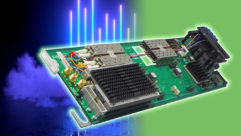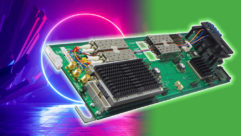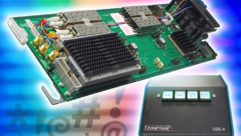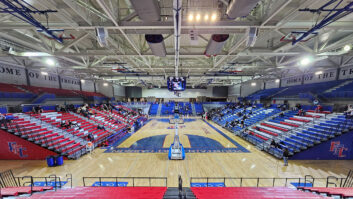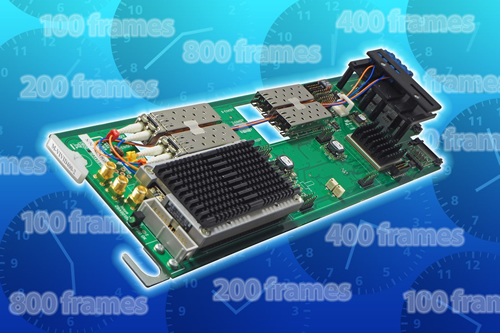
Crystal Vision continues its commitment to being the leading video delay provider with the release of four variable video delays that can work with IP, with SDI or with both IP and SDI at the same time and provide up to 32 seconds of delay. Designed to match any equipment with a processing delay, Crystal Vision’s latest video delays are software apps that run on the MARBLE-V1 media processor hardware and can easily be replaced if needs change. Broadcast engineers can choose a version with the features they need, selecting the required number of channels (single, dual or triple) and the required amount of delay (up to 100, 200, 400 or 800 frames). These are the industry’s first video delays to offer IP connectivity (supporting both SMPTE ST 2022 and ST 2110 video over 10GbE IP networks), while for those working with SDI they introduce a 3G/HD/SD-capable video delay to the Vision frame system for the first time – with the easiest possible upgrade path to IP. The inclusion of IP to SDI and SDI to IP gateway functionality also makes them the ideal video delay for hybrid systems.
The delay is adjustable in steps of frames, with the length of the delay in seconds dependent on the video standard, with 31 different SDI formats supported. For those wanting to maximize the use of their rack space, the triple channel M-VIVID100-3 provides up to 100 frames of video delay per channel (3.33 seconds in 1080i59.94). There are two dual channel video delays, with the M-VIVID200-2 offering up to 200 frames of delay per channel (6.67 seconds in 1080i59.94) and the M-VIVID400-2 up to 400 frames per channel (13.33 seconds in 1080i59.94). Finally the single channel M-VIVID800 provides up to 800 frames of video delay (26.67 seconds in 1080i59.94). These four software apps run on the MARBLE-V1 media processor (a card housed in the Vision frame) which features a powerful CPU/GPU processor, six bi-directional SDI connections and up to four 10GbE SFP+ network interface ports. The VR04 or VR06 frame rear modules are used to access the inputs and outputs.
The M-VIVID range can be used to match any short or long system delays in IP, SDI or mixed installations, such as those caused by virtual studio graphics, MPEG encoders and decoders, audio processing, HD radio links and satellite links. IP systems additionally introduce new types of delay, such as aggregated signal path delays when framestore synchronizers are not used on some of the paths.
Explained Crystal Vision’s Managing Director, Philip Scofield: “Crystal Vision video delays have always helped people with system integration, particularly with virtual reality systems. This latest range of video delays helps solve the same problems when working with IP systems – as well as delay requirements unique to IP systems and the mixing of IP and SDI systems.”
The four video delay apps include many useful features for those working with IP signals. They can be configured for ST 2022-7 redundant streaming or the protect equivalent for ST 2110, with the IP flows able to separated and protected across up to four bi-directional 10GbE SFP+ network interfaces. Their gateway functionality can be used to integrate SDI into an IP environment or IP into an SDI environment, whether those environments are ST 2022, ST 2110 or a mixture of both. Their IP to IP translation functionality can be used for network address translation, protocol conversion (between any of the input formats and any of the output formats), unicast to multicast address conversion and the creation of media firewalls. With the potential for networks and IP receivers to not be very tolerant to bursty traffic, the apps will ensure a nicely constructed IP output (with a choice of traffic shaping options), while their tolerant IP inputs are designed to be robust to bursty traffic.
The video delay apps all include a framestore synchronizer timed to an external Black and Burst or tri-level syncs analog reference or PTP (with fail-over options) – allowing engineers to delay and synchronize at the same time. When delaying SDI or SMPTE ST 2022 the entire video stream is delayed, with embedded audio and ancillary data staying with the associated video – allowing use in embedded areas. The flexible control options include the integrated control panel on the Vision 3 frame, the VisionPanel remote control panel or SBB-4 smart button box, the VisionWeb Control web browser software, complimentary SNMP or Crystal Vision’s JSON and ASCII protocols. Comprehensive SDI, IP and PTP monitoring information is available and can be used to generate SNMP traps. 16 presets can be assigned and recalled, a time-saving feature which allows different delay values to be recalled automatically by the studio control system.
The M-VIVID100-3, M-VIVID200-2, M-VIVID400-2 and M-VIVID800 software apps are all available to buy now.
Based at Whittlesford near Cambridge in the UK and with an office in the USA, Crystal Vision provides a full range of interface and keyers and helps people transition through a range of technologies – from SD to HD, from HD to IP and from IP to IP.


